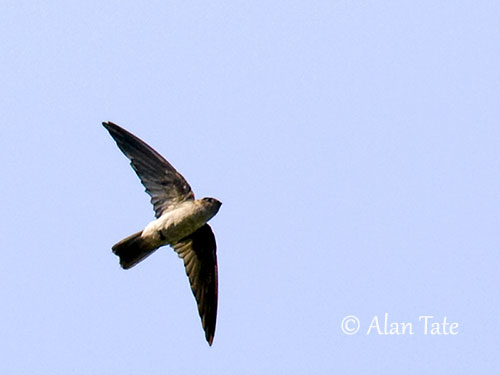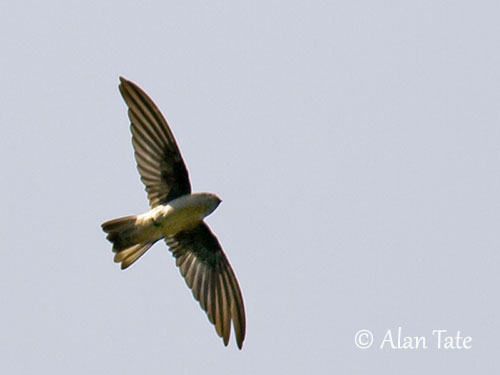
Fr: Salangane des Seychelles
Ang: Seychelles Swiftlet
All: Seychellensalangane
Esp: Salangana de Seychelles
Ita: Salangana delle Seychelles
Nd: Seychellensalangaan
Sd: seychellsalangan
Photographers:
Alan & Ann Tate
AA Bird Photography
Text by Nicole Bouglouan
Sources:
HANDBOOK OF THE BIRDS OF THE WORLD Vol 5 by Josep del Hoyo-Andrew Elliott-Jordi Sargatal - Lynx Edicions - ISBN: 8487334253
SWIFTS - A Guide to the Swifts and Treeswifts of the World – Par Phil Chantler and Gerald Driessens – Editeur: Pica Press, 2000 – ISBN: 1873403836, 9781873403839 – 272 pages
Birds of the Indian Ocean Islands Par Ian Sinclair, Olivier Langrand - ISBN: 1868729567, 9781868729562- Editeur: Struik, 2003
The Birds of Africa: Volume VIII: The Malagasy Region: Madagascar, Seychelles, Comoros, Mascarenes - Par Roger Safford, Frank Hawkins – ISBN: 1408190494, 9781408190494- Editeur: A&C Black, 2013
Birds of Seychelles – By Adrian Skerrett and Tony Disley – Editeur: A&C Black, 2013 – ISBN: 140818124X, 9781408181249 – 176 pages
Wikipedia, the free encyclopaedia
Nature Seychelles - Seychelles Swiftlet
EOL – Encyclopedia of Life – Aerodramus - Cave Swiftlets
Seychelles Swiftlet
Aerodramus elaphrus
Apodiformes Order – Apodidae Family
INTRODUCTION:
The Seychelles Swiftlet is endemic to Seychelles Islands where it frequents a wide variety of habitats. It typically feeds on flying insects taken in the air, and also takes spiders. This species may breed throughout the year and usually nests in caves where it flies in the darkness by using echolocation.
The Seychelles Swiftlet is threatened by destruction of its nesting caves by quarrying. Predators including cats and owls, introduced plant species invading the main foraging areas in marshes and disturbance by tourists also affect this species currently classified as Vulnerable. It is one of the rarest swifts.
DESCRIPTION OF THE BIRD:
Biometrics:
Length: 11 cm
Wingspan: 28 cm
Weight: 10-11 g
The Seychelles Swiftlet is a small Apodidae. It has dark grey-brown upperparts with slightly paler crown and rump. The dark tail is slightly forked. It has much white on the concealed barbs of the back feathers.
The underparts are pale grey-brown with darker undertail-coverts. The dark shafts of the pale grey belly feathers are inconspicuous.
The head is dark grey-brown with slightly browner forehead. Ear-coverts are mid-brown.
Bill, short legs and feet are black. The eyes are blackish-brown.
Male and female are similar.
The juvenile is not described.

RANGE:
The Seychelles Swiftlet is endemic to Seychelles Islands. It occurs on Mahé, Praslin and La Digue. It was formerly present on Felicité.
HABITAT:
The Seychelles Swiftlet frequents a wide variety of habitats including forest, wetlands, gardens, cultivated fields and urban areas. The species is visible from the lowlands up into mountains.
CALLS AND SONGS:
The Seychelles Swiftlet nests in caves where it uses echolocating calls (like bats) when flying in the darkness. It produces regular low-pitched, metallic clicking calls described as “pewterpewter” almost electronic in character.
Among the flying feeding flocks, the birds give soft, twittering calls.
BEHAVIOUR IN THE WILD:
The Seychelles Swiftlet feeds on flying insects, especially flying ants, but also Dipterans, Hemipterans and beetles caught in the air. It also consumes spiders.
It forages and feeds over freshwater and various types of habitats such as wetlands and forest, between 5 and 20 metres above the ground, sometimes higher or lower depending on the prey. It is active at dusk and during the night. The size of the prey is related to the size of the gape of the bird. They fly with wide open bill and hawk insects in the air.
The Seychelles Swiftlet breeds all year round. They are apparently monogamous and generally pair for long periods.
The courtship displays remain poorly understood, but these birds usually perform aerial displays. Both mates fly together while calling. Mating occurs at nest or in the air.
This species nests colonially in caves. One site was created by numerous huge granite boulders in a valley.
The Seychelles Swiftlet is resident, but it may wander to nearby islands.
This species can be seen flying in small groups over rocky outcrops and forested gullies. They are aerial feeders constantly on wing over various habitat types. This species has long, narrow, pointed wings and is a good flier.

REPRODUCTION OF THIS SPECIES:
The breeding season may extend throughout the year. The Seychelles Swiftlet is colonial breeder and nests in rocky caves formed by large granite boulders, between 50 and 250 metres of elevation, but maybe higher.
The nest is a self-supporting bracket made with strands of lichen cemented together with saliva. Nest material may also include dead Casuarina needles or palm fronds. They usually vary slightly depending on both site and island. This structure is probably built by both mates.
The female lays a single egg. The incubation lasts 25-30 days. The chick is fed by both parents perched on sides of nest, including at night while watching over the young. It fledges about 40-42 days after hatching. This long period is thought to be, in part, a function of the need for full independence after fledging.
The fledging success appears very high. Re-laying may occur at least two weeks after failure or success.
PROTECTION / THREATS / STATUS:
The Seychelles Swiftlet has restricted range on three islands. Only one breeding site is known on each island.
The breeding caves are vulnerable to human disturbance, especially on La Digue and Praslin. Barn Owl is a predator of this species, and introduced cats may kill the birds where the nests are accessible to them. Disturbance by tourists also occurs locally. Introduced plant species in marshes also affect these foraging areas by reducing insect numbers.
The population was roughly estimated to number 1,700/2,000 mature individuals in 1996-1997. It is suspected to be stable. But currently, the Seychelles Swiftlet is classified as Vulnerable.